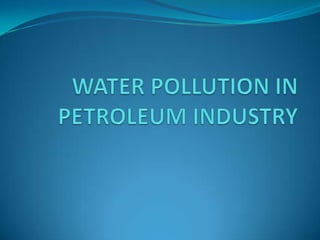
Water pollution in petroleum industry
- 1. WATER POLLUTION IN PETROLEUM INDUSTRY
- 2. Water Pollution Water pollution can be defined as presence of solid, liquid or gaseous contaminants in such concentration that may alter the quality of water. Water pollution is defined as the addition to water of an excess material or heat that is harmful to the living organism or which impairs the beneficial use of water.
- 5. WATER POLLUTION The principal sources of water pollution resulting from exploration and production operations are : Produced Water. Drilling fluids, Cuttings and well treatment chemicals. Process, wash and Drainage water. Sewerage, sanitary and domestic wastes. Spills and leakages and Cooling water.
- 6. Volumes of waste produced depend on the stage of the exploration and production process. During seismic operations, waste volumes are minimal and relate mainly to vessel activities. In exploratory drilling the main aqueous effluents are drilling fluids and cuttings. In production operations – after the development wells are completed – the primary effluent is produced water.
- 7. Oil based drilling fluids and cuttings on the other hand have an increased effect due to its toxicity. Ocean discharges of water-based mud and cuttings have been shown to affect benthic organisms. Oil based mud and cuttings affect benthic organisms.
- 10. The produced water can be one of the largest waste products, by volume, which needs to be managed and disposed off by the oil and gas industry.
- 13. Indian Standards for Industrial Effluents
- 14. Indian Standards for Industrial Effluents
- 15. Indian Standards for Industrial Effluents
- 16. Indian Standards for Industrial Effluents
- 17. Indian Standards for Industrial Effluents
- 19. Other important functions include cooling and lubricating the drill bit, and transmitting hydraulic energy to the drilling tools and bit.
- 23. Then dissolved biological matter is progressively converted into a solid mass by using indigenous, water-borne bacteria.
- 25. What’s an oil spill? When oil of any type is released into the natural environment, the result is termed an oil spill. 24
- 26. Effects of Oil Spills -Environmental effects Because oil floats on top of water, less light penetrates into the water, limiting the photosynthesis of marine plants and phytoplankton. This, as well as decreasing the fauna populations, affects the food chain in the ecosystem. Oil destroys the insulating ability of fur-bearing mammals, such as sea otters, and the water-repelling abilities of a bird's feathers, thus exposing these creatures to the harsh elements. Many birds and animals also ingest (swallow) oil when they try to clean themselves, which can poison them. Depending on just where and when a spill happens, from just a few up to hundreds or thousands of birds and mammals can be killed or injured. The effects of Exxon Valdez oil spill can be seen even now, after 20 years the incident took place. 25
- 27. How do they clean up the oil on the beaches or the water after a spill? The Oil that gets washed up on the shores are mechanically cleaned by Humans. The oil is first absorbed using sorbents. Then the remaining parts are cleaned using shovels. The residual parts are then allowed to break up naturally or biological agents are used to decompose them to carbon dioxide and other less toxic components 26
- 28. Tools for controlling Oil Spills Mechanical:- Booms: large floating barriers that round up oil and lift the oil off the water Skimmers: skim the oil Sorbents: large absorbents that absorb oil 27
- 29. Contd….. Chemical:- Chemical and biological agents: helps to break down the oil Vacuums: remove oil from beaches and water surface 28
